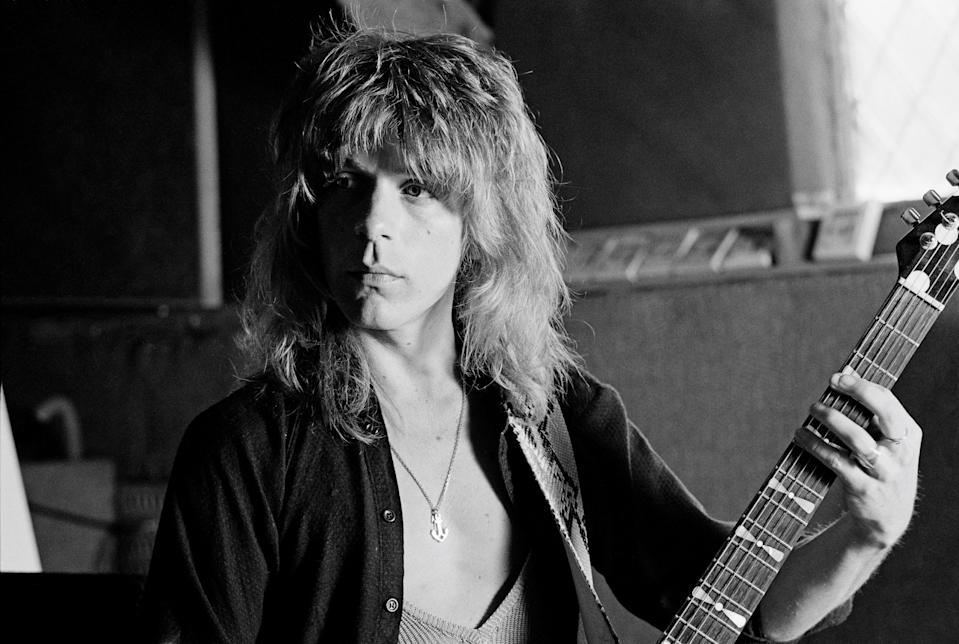Forty years ago, Randy Rhoads died in a plane crash while on tour with Ozzy Osbourne in Florida. The classically trained metal guitarist was only 25 years old when he died, and had only come onto the scene recently as the guitarist and co-songwriter for Osbourne’s first two solo albums. Yet he left behind an incredible, indelible legacy thanks to his lightning-speed, virtuosic soloing, which helped define the ‘80s metal sound and influenced guitarists for decades to come. In fact, just last year, Rhoads was posthumously inducted into the Rock & Roll Hall of Fame.
Rhoads’s pal Rudy Sarzo, who played with the legend in the late-‘70s, pre-fame Quiet Riot lineup and was recruited by Rhoads to play bass for Osbourne in 1981 — and was present at the crash and nearly boarded the plane that day — has had a major part in keeping his late bandmate’s legacy alive for decades. He even wrote a book, Off the Rails: Aboard the Crazy Train in the Blizzard of Ozz about his bond with the guitar god.
[embedded content]
“There’s a reason why I wrote the book,” Sarzo tells Yahoo Entertainment. “I wrote it because I have to go back. Sometimes I go back as a spectator, and that way, I avoid feeling the pain again. I go back and I actually see myself in the place at the moment, but I’m disconnected from it, because it’s like I’m watching myself go through this. But for this [Yahoo interview], I had to go in as myself, rather than as a witness. But it is my choice to do that — because it is very important that I am able to convey the emotion of what happened that day.”
Sarzo, who joined Quiet Riot in 1978 a year after moving to Los Angeles from Florida, recalls there was a “single motivation” in that band’s fledgling Sunset Strip days: “to get a record deal.” When that didn’t happen, Rhoads, who grew up in a musical family and had a steady gig teaching guitar at his family’s Musonia music school, considered giving up on his rock-star dream. “It was a very different Randy back then, before he joined Ozzy,” Sarzo explains. “He did not even want to [audition for Osbourne’s band]. He was still living at home. He was teaching about eight hours a day. He had a pattern. He had a girlfriend. He was comfortable. He still had a love for Quiet Riot, but his mom knew how much Quiet Riot was struggling to get a deal and make it. And she’s the one who advised him and said, ‘Listen, Randy, this might be your only opportunity to become a recording artist. If you don’t take this offer from Ozzy, it might never come around again.’”
It turned out mother knew best: Osbourne and Rhoads were a perfect fit. “When Quiet Riot would get together to write new songs — so we could get a record deal — it was pretty much trying to please the record company. But once Randy joined Ozzy, Randy asked, ‘What do you want me to write for this record that we’re making?’ And Ozzy said, ‘Just be yourself.’ And that’s when Randy was able to go back to his classical music roots and incorporate that into that first record,” Sarzo explains. “And it was a metamorphosis. Randy found complete creative freedom in playing with Ozzy.”
Sarzo says he was “just a guy sleeping on [Quiet Riot frontman] Kevin DuBrow’s floor” when Rhoads recommended him for Osbourne’s band. “I had no résumé. Nobody knew about me. But Randy kept telling Ozzy and Sharon, ‘Hey, Rudy is the guy that you’re looking for,’” Sarzo recalls, still sounding deeply grateful all these years later. Soon, Rhoads and Sarzo were on the road with Osbourne making heavy metal history (including that notorious night in Des Moines when Osbourne bit the head off a bat), and Sarzo was awestruck every evening by Rhoads’s playing.
[embedded content]
“Randy was an incredibly creative human being,” Sarzo marvels. “You know, when you spend your days on tour recreating [an album onstage], you’re not creating anymore; you’re recreating what you just did. And that did not work for Randy. He needed the outlet to be creative every single day. So, what he would do is he would perform variations. He would take what he recorded to the next level, every single night. He decided he was going to play a little bit differently every night, just for the sake of being creative. He challenged himself every time. And I saw that. I mean, what you hear on the records, by the time that he was onstage performing, it was like beyond what he had done in that moment.”
But this magic was tragically short-lived. On March 19, 1982, just a year after Sarzo had joined Osbourne’s band, their tour bus made a stop at Flying Baron Estates in Leesburg, Fla. — a property owned by the Calhoun Brothers tour bus company, in what Sarzo describes as “that community outside of Orlando where people own their own airplanes and just park them in their backyard.” The bus driver had stopped there to just fix the bus’s broken air-conditioning unit, but then an impromptu joyride in one of the estate’s planes ended in disaster.
“It always starts as just another day,” muses Sarzo, as he begins to recount the harrowing tale. “It was just another beautiful morning, after playing the night before in Knoxville, Tenn.” While the AC was being fixed, the bus driver and private pilot Andrew Aycock, without permission, took a single-engine Beechcraft F35 plane out for a couple of spins. During their first flight, which had keyboardist Don Airey and tour manager Jake Duncan on board, Aycock buzzed the bus to try wake drummer Tommy Aldridge; Osbourne and Sarzo were also sleeping on the bus. When Rhoads — who, ironically, was afraid of flying, but wanted to take some aerial photos for his mother — roused Sarzo and invited the bassist to join and Sharon Osbourne’s assistant, makeup artist Rachel Youngblood, for the second flight, Sarzo considered. But instead, Sarzo pulled the curtains shut on his bus bunk and went back to sleep.
“Now, I was raised in Florida, and the Diary of a Madman tour started off in winter, and we had been touring up North. So, finally, we had got to the sun! I grew up in the sun, so this was great. And all wanted to do was just get to the hotel and lay by the pool. It was going to be our day off. And this was the first time that I ever turned down any adventures that Randy and I would do on the road,” Sarzo recalls. “That is scary, because I used to take so many chances back then. Just the fact that it would happen in Florida, where I grew up. … If it would have happened in any other city, there was a possibility that I would’ve joined Randy [on the plane]. I can’t really say there was any premonition that kept me from getting on that plane. It was a destiny.”
During the doomed second flight with Rhoads and Youngblood as passengers, Aycock tried buzz the tour bus again; on his third attempt, one of the plane’s wings clipped the top of the bus, causing the fiery crash. Rhoads, Aycock, and Youngblood were killed instantly.
“I was awakened by this boom — it was like an impact. It shook the bus. I knew something had hit the bus,” Sarzo recalls grimly. “I opened the curtain, and I saw the door opening as I was climbing off my bunk. There was Sharon, Ozzy running out. There was a door that divided the [tour bus’s] front lounge from the sleeping area, and as we entered the lounge, there was glass blown out of the window on the passenger side of the bus. And I looked out and I saw our tour manager [Duncan] on his knees, pulling his hair out and yelling, ‘They’re gone!’ And we didn’t know what was going on.
“So, I follow Sharon out of the tour bus, and there’s the wife of the bus driver, standing frozen on the doorway at the exit of the bus,” Sarzo continues, noticeably shifting to speak in the present-tense. “Sharon pushes her to one side and we go out, and I look over where our tour manager is on his knees, and there’s a colonial-style house. And the garage is on fire. I still don’t know what’s going on. But some pieces of information start falling into place. Sharon’s trying to get out of Jake what is going on, and he just keeps yelling: ‘They’re gone! They’re gone!’ And then it’s revealed that they were on a plane, and it crash-landed into the garage and it exploded on impact.
“I look at people’s mouths that are moving. I can’t hear what they were saying. This helplessness, this hopelessness, just overtakes me — realizing that fire, they’re being consumed by it, Randy and Rachel. … This was 40 years ago; there was no technology. To let the fire department police know that this had happened, it took a while. It actually took people that were on horseback who saw the flames and smoke and called in the police. We were stranded there for two hours, with no first responders coming on site.
“Now, there’s a 99 percent disbelief. One percent of me is probably embracing what just happened — like, this really happened. The other 99 is denying it. All I hear is a low hum. I’ve never heard anything like that before. And hopefully I’ve never hear it again.”
Sarzo says “the aftermath was just as horrible — having to deal with reality as we were leaving the site of this tragedy,” and “the survival guilt hit us very, very immediately.” Still feeling “shell-shocked” and despondent hours later in his hotel room, he wandered outside and ended up in a church, where he had an encounter with his boss that resonated with him for life.
“I’m in the very last row of the church, just trying to find some peace of mind and some answers. And I keep hearing somebody in the front really in pain — more pain than me, because I was in shock. Of course I was in pain, but I was too shocked to really feel pain. I was numb. And this person was like, moaning and groaning, really in touch with their emotions. I had no idea who it was, and it got to a moment that I said, ‘I gotta look.’ And then I realized it was Ozzy — in the same church with me, going through this painful experience. So, we all dealt a little bit different, because Randy meant different things to everybody. With Ozzy, Randy was the person that was able to help him break away the from Sabbath shadow and come into his own. Randy to me was a mentor and a brother, and the person that gave me a career by introducing me to Sharon and Ozzy. We all had different connections with Randy emotionally. But they were all wonderful.”
Sarzo, who was a pallbearer at Rhoads’s funeral but tells Yahoo Entertainment he’s “not prepared” emotionally to discuss that specific experience in this interview, stayed in Osbourne’s band until September 1982. But he understandably became disillusioned with the experience and eventually returned to Quiet Riot, who went on to great success in the ‘80s with Metal Health, the first heavy metal album to go No. 1 on the Billboard 200 chart.
“After Randy Rhoads died, nothing was ever the same again. My reference of being with Ozzy was Randy. He’s the one that got me in the band. So, once he wasn’t there anymore, I lost my family within Ozzy,” Sarzo explains. “I’m not saying that Sharon and Ozzy were not wonderful with me, because they were. But they were very, very different from me. Randy and I basically came from the same background — I was raised in Miami, and Randy was from L.A., and then you have Ozzy, who was from Birmingham, England, raised in the rubble of World War II. So, Ozzy had a whole different outlook on life, doom and gloom, while mine and Randy’s was sunny. Once that [bond with Rhoads] was gone, it was like, ‘Wow, this is just doom.’ … When Randy passed away, it was very difficult, to say the least, to continue without him.”
Sarzo believes that had the insatiably creative Rhoads lived, he too would have eventually left Osbourne’s band — and gone back to school. “Randy wanted to get his master’s degree in music and enter the New York studio scene,” Sarzo reveals. But he says there “major plans” for the Rhoads-lineup Ozzy era, including a live album, that sadly never came to fruition. Still, he’s forever grateful and humbled to have had shared a stage with his late friend and get to reminisce about the experience.
[embedded content]
“A lot of people complain that they think that Sharon and Ozzy are hiding footage of Randy era. But I was there. I knowhow much footage was actually taken of us performing live, which is like virtually nothing,” sighs Sarzo. “There might be some B-roll that the local news station was allowed to take of the first couple of songs in certain cities, but there would be no sound to go along with that. But we played live in front of a lot of people, so there were a lot of witnesses for Randy’s incredible talent and his amazing, amazing display. … And that’s why it’s important to me, when people want to know about Randy, that I’m able to share with them.”
Read more from Yahoo Entertainment:




